The Hocking Hills State Park - Ohio
Hocking Hills State Park is one of Ohio's most beautiful natural areas. Consisting of six different sites, the park offers the naturalist or hiker incredible vistas of towering cliffs, natural waterfalls and deep shaded gorges.
Old Man's Cave
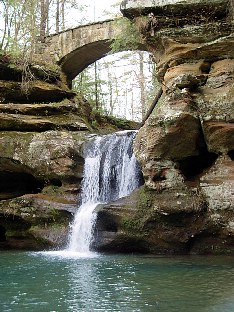
Old Mans Cave lends its name to the full length of the magnificent scenic gorge that it is located in. The gorge cuts through a 150 foot thick bed of Ohio Blackhand sandstone and rambles for approximately mile.
This natural masterpiece is primarily the result of water erosion started many thousands of years ago, as the massive glacial ice sheets that once covered (what is now) Ohio, began to melt and formed running torrents of water at the edge of the Ohio plateau. The torrent that carved this canyon is now known as the rather placid Old Mans Creek.
The gorge is divided into five distinct topological areas; the Upper Falls, the Upper Gorge, the Middle Falls, the Lower Falls, and the Lower Gorge.
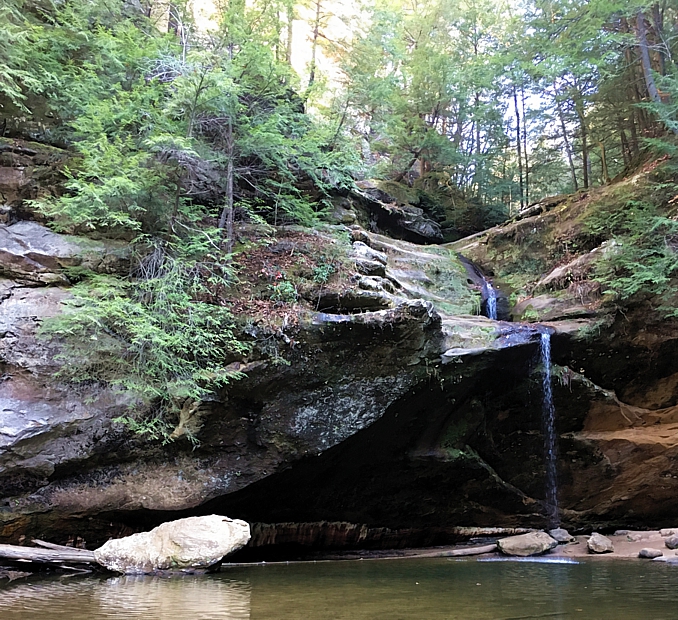
The main recess cave known as Old Mans Cave is located near the base of the Middle Falls along a vertical cliff about 75 feet above the stream bed. This recess cave is roughly 200 feet long, 75 feet deep and about 50 feet from rim to floor.
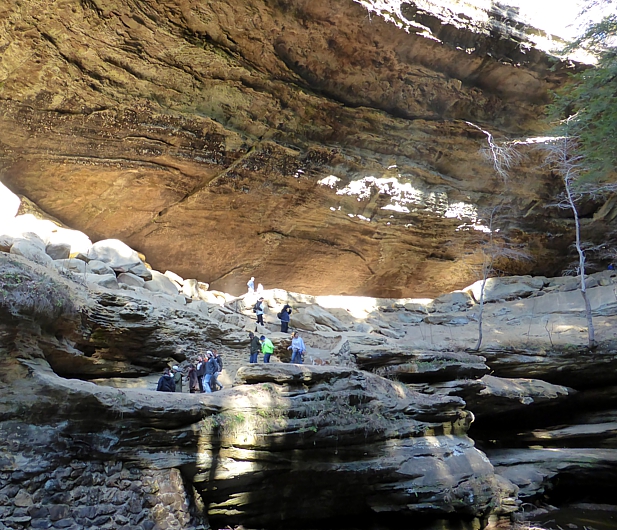
Richard came to the Ohio Valley territory with his parents, who established a trading post around 1796.
Throughout his life Richard made numerous hunting forays into the wilderness which led him to find the Hocking Hills are and the sandstone gorge.
Richard was so taken by the beauty and solitude of the area, he and his two dogs set up living quarters in one of the larger recess caves. Rowe lived out his life here until (allegedly) he was killed by an accidental discharge of his own rifle. According to local legend, Indians who had befriended Rowe discovered his body and buried him somewhere in the gorge he loved so well. Today, it is believed that his body lays buried beneath the ledge, near the entrance of the main recess cave.
|
Just as at Ash Cave, there is strong archaeological evidence that indicates that the gorge, caves, and over-hangs provided shelter for native American hunters, explorers and settlers for many centuries. |
|
|
Many of the fantastic rock formations hanging over your head seem to be perched quite precariously, but they have been here for centuries. The greater danger is hiking the upper trails in winter or during the rainy seasons when the trails and rocks along the rim are quite slippery. I have slipped off of a high ledge here several years ago and it was certainly no fun . . . however, I'm still here to tell the tale. (Read my "Over the Cliff" account.)
The hiking
trails within Hocking Hills State Park are part of Ohio's 1,445 mile
"Buckeye Trail" and are segments of two national hiking trail
systems as well, "The North Country Scenic Trail" and "Americas
Discovery Trail." When hiking in the Hocking Hills, be
aware! The terrain is rugged in some locations and the cliffs are
quite high. Many (such as yours truly) have had unfortunate accidents here so be smart,
be safe. Also watch out for Ohio's poisonous copperhead snakes
(additional personal experiences), the large Timber rattlesnakes, and
numerous poisonous plants. by: Dr. Von Zuko © 2017 |
|
Ash Cave
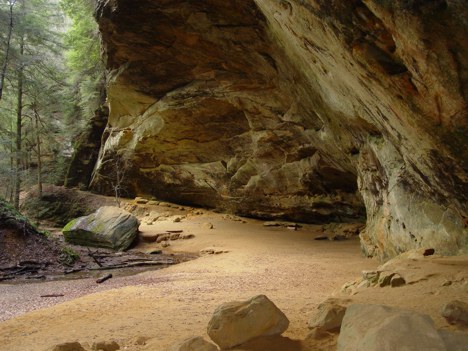
One of the most impressive prehistoric rock shelters in Ohio is Ash Cave, located at the southernmost perimeter of the Hocking Hills State Park system. Ash Cave, referred to as a recess cave, was carved into the softer lower layers of the colorful Ohio 'Blackhand' sandstone by millions of years of water and wind erosion.
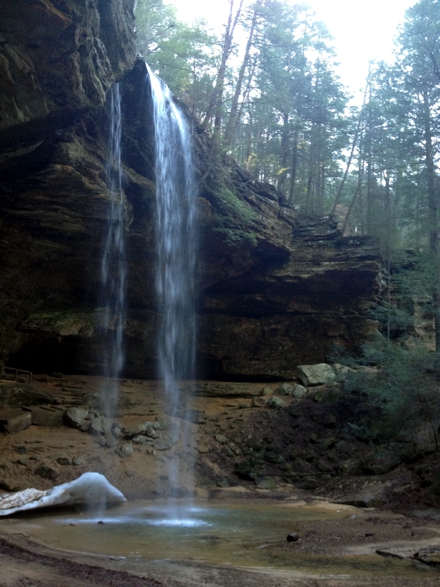
These photos are a bit deceptive in that the horse shoe shaped Ash Cave is over 700 feet wide and 90 feet high to the lip of its water fall. The cave is immense and for perspective, consider that the large boulder in the creek bed to the left, is about six feet tall, and ten feet long. The recess of Ash Cave is also fairly deep at around 100 feet, which made it a perfect shelter for ancient hunting parties of the stone age.
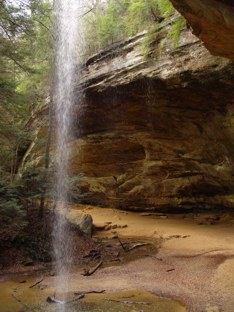
The ash deposits were quite large and extended nearly the width of the cave, sometimes extending to a depth of more than three feet.
Archaeologists theorize that the ashes were from hundreds of campfires built over the centuries by the hunter gatherer people that roamed this part of the state about 7,000 years ago.
Many stone artifacts, animal bones and
plant residue have been found in the ashes and around the cave,
indicating a long period of human use.
There is also strong archaeological evidence that indicates the cave was a stop-over in later centuries for travelers on the old Indian trails traveling to the Shawnee villages along the Scioto River.
The cave had also served as a workshop
for the grinding of grains and the manufacture of stone tools.
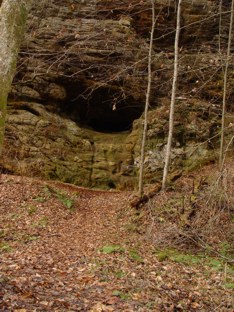
As you hike down the narrow quarter mile gorge you'll notice a number of small over hangs and caves. You can only wonder how many weary ancient travelers took shelter in their recesses. On a still fall day when you are there alone, you can almost hear the murmur of ancient voices.
Ash Cave Hours: Hocking Hills State Park opens one half hour before sunrise and closes one half hour after sunset. The park is open year-round.
|
A number of uncommon and even rare plants are found in this area,
including plants that are outside their normal range. Canadian yew, bigleaf magnolia and many others may be found here. |
|
|
When hiking in the Hocking Hills, be aware! The terrain is rugged in some locations and the cliffs are quite high. Many have had unfortunate accidents here so be smart, be safe. Also watch out for Ohio's copperhead snakes, rattlesnakes, and poisonous plants. |
Cedar Falls
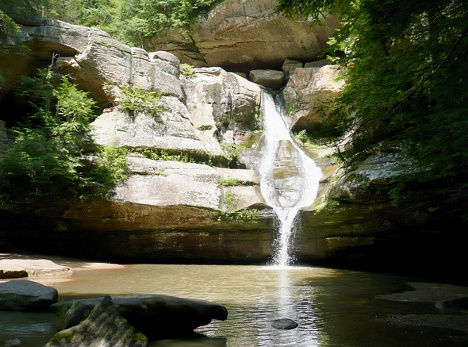
In the list of Ohio waterfalls, Cedar Falls ranks high among the most picturesque. In the spring the outflow from the ... This photo was taken in August of 2009 and the flow is probably about half of it's Spring time volume.
Cedar Falls tumbles over a fifty foot cliff of Black Hand sandstone. Cedar Falls has been the subject of many an artist's canvas and a source of inspiration for many photographers.
Prehistoric Shelter:
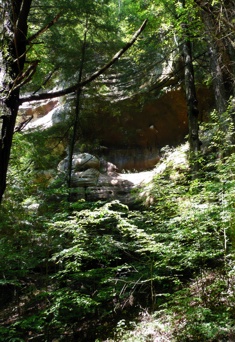
As you walk through the Cedar Falls gorge you will see several recess caves perched half way up the rock face. These recess caves have provided protection and shelter for centuries. First used by prehistoric man as long as 10,000 years ago, to explorers and early settlers, these ledges have quite a history.
Various stone artifacts such as arrowheads, knives and scrapers as well as animal bones from ancient meals have been found in and around the rock shelters.
Please note: In the interest of
preservation, these areas are posted as "closed" to foot traffic.
Please be sensitive to the incredible history here and stay on the
trails. You can still appreciate and photograph these rock
shelters from the trail.
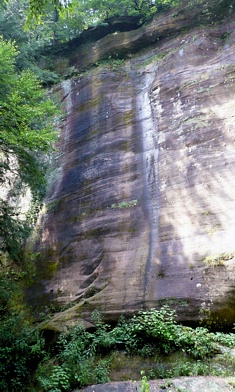
The Early Settlers:
Cedar Falls received its name when the first settlers to the area incorrectly identified the abundant Hemlock trees thriving in the gorge as Cedar trees.
In the 1830's settlers to the area, built a small grist mill above Cedar Falls to use the streams forces to grind grain. The mill is only noted in historical documents and there is no longer a trace of its existence.
The Landscape:
When hiking in the Cedar Falls gorge, be aware! The terrain is rugged in some locations and the cliffs are quite high. This rock wall face on the left is roughly 115 feet high. The trails at the top offer spectacular views but also obvious danger! Over the years of human visitation, many careless visitors have had unfortunate accidents here. Stay alert and stay safe. Also watch out for Ohio's copperhead snakes, rattlesnakes, and poisonous plants.
The trails at the bottom of the gorge are well marked and for the most part, level and fairly easy to walk. Several foot bridges span the stream at various choke points in the canyon. Keep in mind however that the difficult part is going down into the gorge and coming up is even more strenuous. Know your limitations and be sure to carry some water.
Rock House
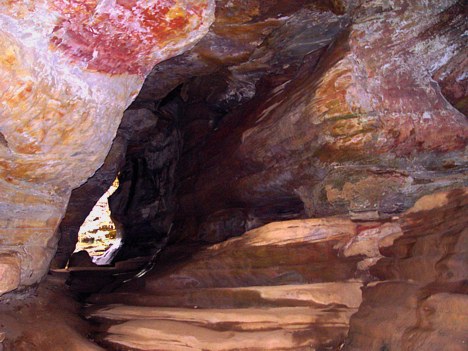
In the list of prehistoric rock shelters and caves scattered across the southern part of Ohio, one of the more impressive shelters is a cliff top cave known as Rock House.
Located in Ohio's Hocking Hills State Park, this unique 200 foot wide cave with Gothic-like arched openings across its face, has a truly fascinating history. Rock House has served as a shelter for Paleolithic big-game hunters near the conclusion of the last Ice Age, and a hide-out for outlaws and horse thieves in the 1800's when it was know as Robber's Roost. Today, it provides a wonderful portal into Ohio's colorful past.
Rock House is perched near the top of
a 150 foot vertical sandstone cliff which gave its occupiers a
highly defensible shelter. The cave is 200 feet long across
the face of the cliff and varies from 20 to 30 feet wide. With
it's 25 foot ceiling, Rock House provided excellent shelter
from the elements as well.
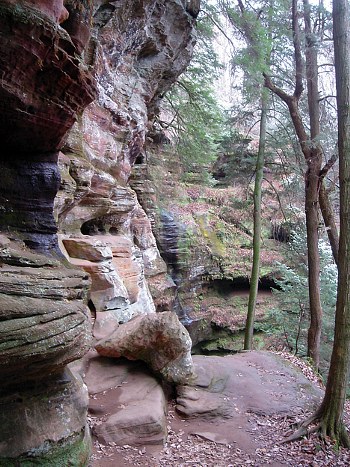
In this photo you see the entrance to Rock House from a narrow trail gripping the cliff face. The small pad-like stone (between the 3 trees) isolates the visitor from the entrance and a 65 to 70 foot fall. The little step protrusion to the left, takes you up through one of the caves arch-like openings and into the main cave.
Inside Rock House (you will need a flashlight) you'll find a number of interesting natural and man-made features. Most prominent are the vivid red, brown, and orange color patterns on the walls and ceiling produced by the staining process of naturally occurring iron compounds.
In the small recesses in the back wall of the cave, you will find ancient baking ovens that were once used by the indigenous people who lived here in prehistoric times. You will also find intentionally carved troughs in the floor that archaeologists believe were used to catch and store fresh water.
Many stone artifacts, animal bones and plant residue have been found in and around the cave, indicating a very long period of human use.
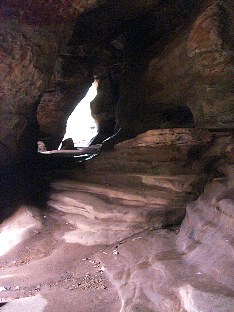
Directory: Scenic & Majestic
- Old Man's Cave
- Ash Cave
- Cedar Falls
- Rock House
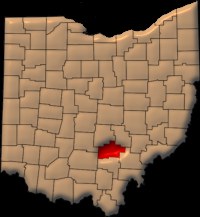
Old Man's Cave is one of six natural attractions located within Ohio's
Hocking Hills State Park.
The park is open year-round and opens one half hour before sunrise and closes one half hour after sunset. Hocking Hills State Park has over 25 miles of hiking trails which ramble through some of the most beautiful and dramatic scenery you find anywhere.
Additional Park Information:
Hocking Hills State Park
19852 State Route 664 S.
Logan, OH 43138
Park Office: (740) 385-6842

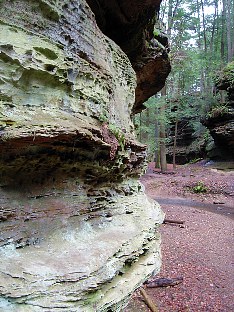
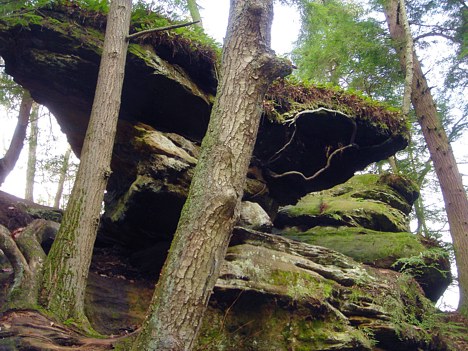


 The
colorful birds you see nesting and flying around the top recesses of
the cave are Rock Pigeons. Their original native habitat was
on the high cliffs of Europe. Their early ancestors stowed away on
the masts of sailing ships and crossed the Atlantic Ocean with the
settlers into America.
The
colorful birds you see nesting and flying around the top recesses of
the cave are Rock Pigeons. Their original native habitat was
on the high cliffs of Europe. Their early ancestors stowed away on
the masts of sailing ships and crossed the Atlantic Ocean with the
settlers into America.